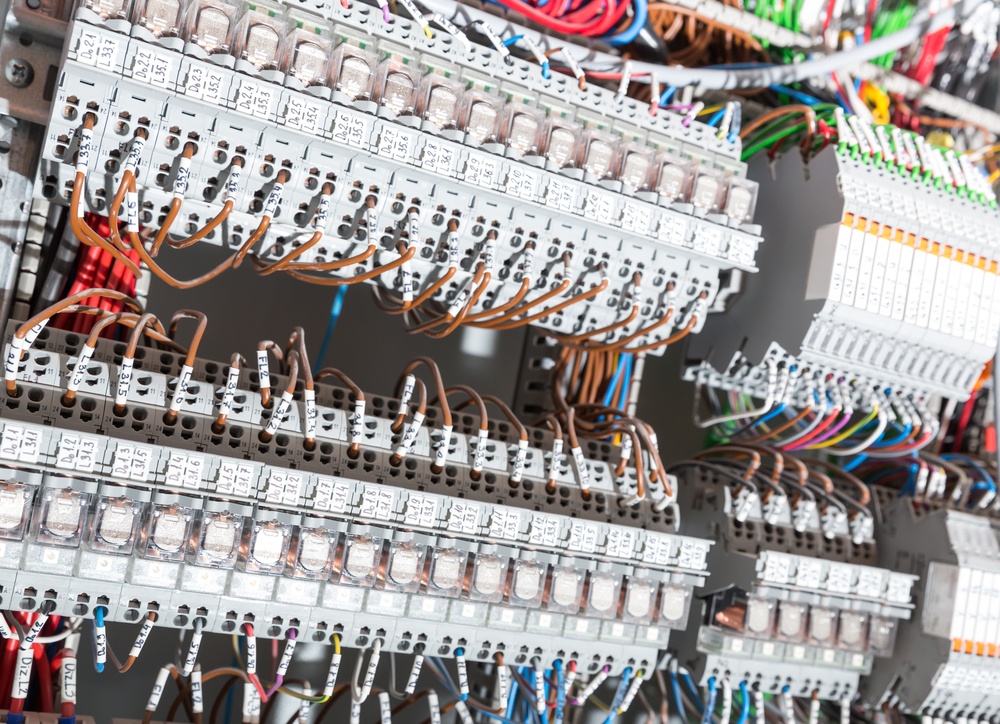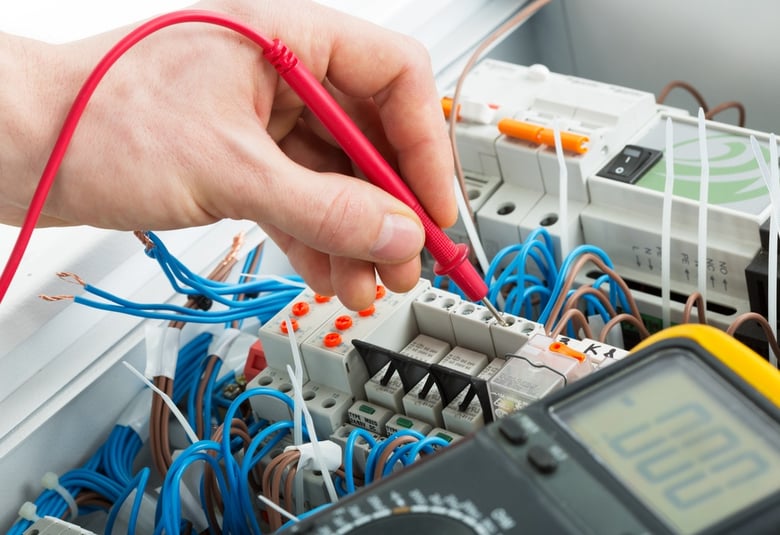Smart Switchgear Solutions are Key to Energy-Efficient Management of Chicago Buildings

In electrical power systems, switchgear comprises various fuses, circuit breakers, and electric disconnect switches that are designed to protect, control, and isolate equipment operating with electricity. If there is a fault, switchgear will de-energize the equipment and clear downstream faults.
While the primary purpose of switchgear is to protect electrical installations and people in this way and to allow electrical equipment to be de-energized, in this day and age, switchgear is also a vital part of energy management systems (EMS). Well-designed electrical systems are both safe and efficient and they play an important role in reducing energy usage and power bills.

An electrician uses a multimeter probe at an electrical switchgear cabinet
On a greater scale, the US Department of Energy (DOE) is implementing a strategy for a national clean-energy Smart Grid utilizing switches and surge arresters to make the grid more reliable.
MEP Engineers and Switchgear Designs
Just one of the many important electrical engineering services offered by mechanical, electrical, and plumbing (MEP) engineers in Chicago and other cities, in addition to performing a reliable and efficient protective function, smart switchgear is designed to:
- Facilitate lighting control
- Measure load at various centers
- Interrupt short circuits and overload faults
- Control circuits on demand and provide circuit isolation from power supplies
- Provide surge protection
- Produce condition information
One of the issues is that whether we are at home or at work, we rely on electrical supply systems to keep machines, appliances, and electronic devices going. Linked directly to power supply system, the switchgear system ensures that systems operate efficiently and safely, and manage electrical loads that vary a lot, or are intermittently and often unpredictably increased.
Even though engineers have used low voltage switchgear in commercial and light industrial installations for decades, technology has changed radically in recent years.
From Functional to Smart
Originally, switchgear was functional and fundamental in terms of safety, but it wasn’t smart.
So what do we mean when we say that the switchgear we use today is smart?
Smart switchgear solutions are designed to safeguard everything in a facility, from laptop computers to huge, powerful manufacturing machines. Furthermore, today’s switchgear has the ability to “communicate” with other elements and devices. This is one of the reasons quality switchgear is invaluable nowadays.
In modern working and living environments, we need power that is steady and continuous even though our activities result in constant changes to this load. For this reason, designers and manufacturers of contemporary switchgear have changed their approach and rely heavily on extensive control parameters that can balance loads and isolate faults, preserving the quality of the mains electricity supply.
But there is a caveat. Because all the components must communicate with each other, it is essential that all elements are compatible. Incompatibility can result in catastrophic results even if the system works at first. Like all things in life, stress can trigger problems and these can soon spiral out of control even if they have been operating successfully for some time.
Modern switchgear panels are intricate spaces that demand extremely high levels of expertise in terms of both design and installation. Additionally, it is essential for there to be a dedicated space (or zone) above the electrical equipment for future access to the system for maintenance, repairs, and possible replacement of parts.
A competent and experienced MEP engineer will design a compatible switchgear system, but specifiers and installers also have a responsibility to check compatibility and make sure that the switchgear is installed correctly.
Implications of Aging Switchgear Systems in Old Buildings
While some manufacturers of switchgear do offer kits to upgrade old components, if the systems are really old there may not be a clear-cut service history and so nobody is going to be able to predict if it will perform to levels that are required by current legislation. Maybe it will, maybe it won’t! In any case, if there was a serious fault that caused cranky old breakers to trip, the likelihood is that nobody would be able to re-set them.
The other thing is that attempting to install modern switchgear together with old components in what is probably a redundant system is simply asking for trouble.
Instead, retrofitting entire switchgear systems is a much more sensible option because it provides a relatively instant opportunity to improve the building’s electrical efficiency.
Whichever route is chosen, it is essential that the switchgear components and ultimate system meet the requirements of both the National Electrical Code (NFPA 70) and various Chicago Codes including the Chicago Building Code.
Codes that Affect Switchgear Requirements in Chicago Buildings
The National Electrical Code (NEC) has been adopted in all of the United States’ 50 states and it is the benchmark for safe electrical design as well as the installation of electrical systems and proper inspection methods. The ultimate aim of the Code is to protect both people and property from the risks associated with electrical hazards, including fire and electrocution. An American national standard, states and municipalities (most of which incorporate the NEC in their local building codes) use it to try and ensure that safe electrical practices are enforced nationwide. The dedicated zone mentioned in From Functional to Smart above is a requirement of this Code.
Switchgear is included in a number of Chicago municipal codes http://chicago-il.elaws.us/search/code including the Code of Ordinances’ Chicago Electrical and Building Infrastructure Codes, and the Building Code and related excerpts of the Municipal Code. Mostly, requirements relate to wiring and protection, equipment required for switchgear and assemblies, as well as electrical equipment for general use. Isolating means, isolating switches, protection requirements, and grounding of devices are also covered.
Of course, installation of equipment in switchgear rooms is important, as are sources of power, conductors, and enclosure for electrical installations. There are also sections that refer to approved auxiliary sources and circuit-interrupting devices.
MEP Engineers are Key to Smart Switchgear Solutions
Switchgear is fundamental to the energy-efficient management of Chicago buildings, but you need an experienced MEP engineer https://www.ny-engineers.com/mep-engineering-services/electrical-services to design a system that will work for your unique situation. New York Engineers has many years of experience with switchgear systems and we are available to work with our Chicago clients to add protection to their switchgear systems, at the same time improving productivity and saving costs. Call us for a consultation.

Michael Tobias
Michael Tobias, the Founding Principal of NY Engineers, currently leads a team of 50+ MEP/FP engineers and has led over 1,000 projects in the US
Join 15,000+ Fellow Architects and Contractors
Get expert engineering tips straight to your inbox. Subscribe to the NY Engineers Blog below.


